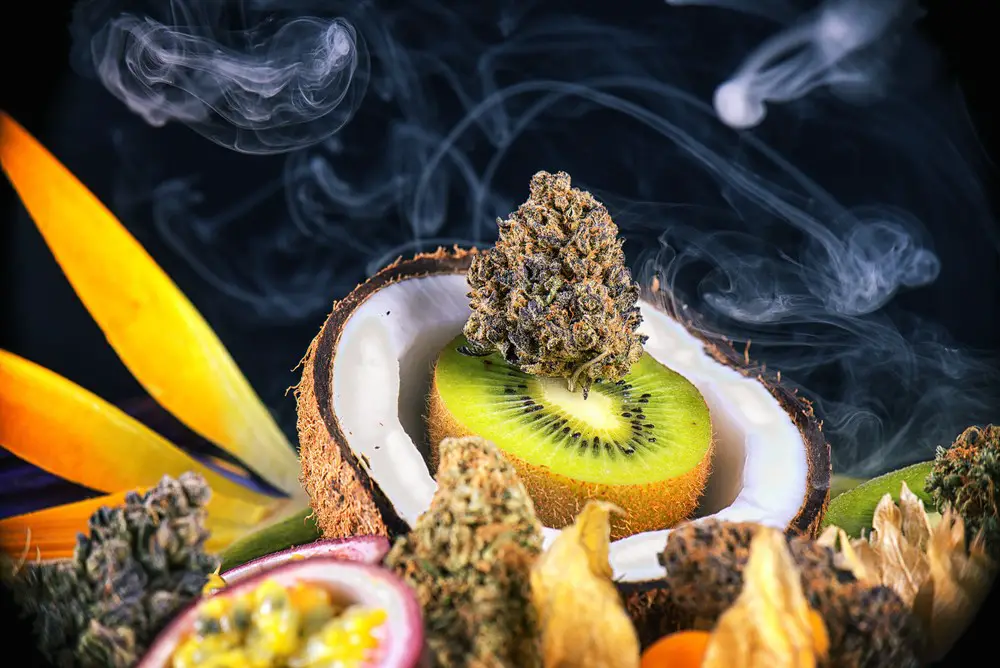If you love cooking, you’re probably aware of how crucial flavor and aroma are for creating mouthwatering dishes. But did you know that natural compounds, known as terpenes, can significantly elevate your culinary creations? These terpenes are found in various plants, fruits, herbs, and all cannabis strains. They contribute to different plants’ unique scents and tastes and offer potential health benefits, including anti-inflammatory, anti-microbial, and antioxidant properties.
In this blog post, we’ll explore terpene-rich ingredients in your recipes and how they might add a new dimension to your cooking.
 Citrus Fruits: A Zesty Addition
Citrus Fruits: A Zesty Addition
Citrus fruits, including oranges, lemons, limes, and grapefruits, boast an abundance of limonene, a terpene renowned for its refreshing and uplifting scent. Limonene might also have potential benefits, such as reducing inflammation, anxiety, and stress. Incorporating citrus fruits into your dishes can infuse a zesty touch.
Consider making a citrus vinaigrette by mixing lemon juice, olive oil, honey, and a pinch of salt, then drizzling it over a green salad adorned with feta cheese and walnuts. Alternatively, you could craft a lemon tart featuring a buttery crust, a creamy lemon curd filling, and a fluffy meringue topping. Or perhaps create a citrus punch using orange juice, lemonade, ginger ale, and sliced fruits, served either chilled or over ice.
Aromatic Herbs: Elevating Flavors
Aromatic herbs such as basil, rosemary, mint, and thyme boast various terpenes, including pinene, myrcene, linalool, and caryophyllene. These terpenes can introduce many flavors and aromas to your dishes, ranging from piney and earthy to floral and spicy. Additionally, they may offer benefits in combating infections, inflammation, and pain.
Elevate your soups, sauces, meats, and vegetables with aromatic herbs. Create a basil pesto using basil leaves, garlic, pine nuts, parmesan cheese, and olive oil, and toss it with pasta, chicken, or roasted vegetables. Alternatively, craft a rosemary garlic butter blend with butter, garlic, rosemary, and salt, perfect for spreading over bread, steak, or potatoes. For those with a sweet tooth, mint chocolate chip ice cream made from vegan milk, vegan cream, sugar, mint leaves, vanilla extract, and chocolate chips, frozen until firm, could be a delightful treat.
Cannabis: A Complex Flavor Profile
Cannabis, also known as marijuana, boasts a wide array of terpenes, such as terpinolene, humulene, ocimene, and nerolidol. Depending on the strain and extraction method, these terpenes can create intricate and unique flavor and aroma profiles. They may also offer potential benefits in preventing oxidation, cancer, and insomnia. Incorporating cannabis into your culinary creations could lead to both psychoactive and therapeutic effects.
However, it’s vital to exercise caution regarding dosage, potency, and the legal and ethical aspects of using cannabis in cooking. For instance, you might consider making cannabis-infused brownies using ingredients like butter, sugar, eggs, flour, cocoa powder, baking powder, salt, and cannabis oil and then baking them in the oven.
Alternatively, a cannabis-infused tea can be brewed by simmering water, tea bags, milk, honey, and cannabis buds on the stove. For a unique twist, try crafting a cannabis-infused pizza, using pizza dough, tomato sauce, cheese, toppings, and cannabis oil, then baking it perfectly.
In Conclusion: More Exploration Needed
Terpenes offer exciting possibilities for enhancing your culinary journey with their flavors, aromas, and potential health perks. Terpene-rich ingredients such as citrus fruits, aromatic herbs, and cannabis can add a new dimension to your cooking, but remember, more research is needed to understand their effects fully. Here are some tips to keep in mind when experimenting with terpene-rich ingredients:
- Experiment with different combinations to find what suits your palate best.
- Opt for fresh and organic ingredients whenever possible to preserve the quality and potency of the terpenes.
- Store terpene-rich ingredients in a cool, dark, dry place to prevent degradation.
- When it comes to cannabis edibles, be mindful of dosage and potency, and consult a healthcare professional if you have medical concerns.
We hope you enjoyed this blog post and found it informative about the potential of terpenes in culinary applications. Remember, while terpenes hold promise, further exploration is necessary to unlock their full potential in gourmet cooking.

